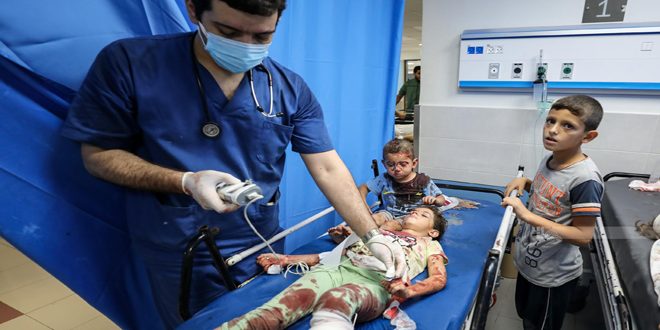On the eve of the Palestinian Child Day, Ola Awad, President of the Palestinian Central Bureau of Statistics (PCBS), highlighted the reality of the Palestinian children’s situation in a report released on Thursday.
A press release published by WAFA News Agency on Thursday, said that the expected number of children under 18 years of age by mid-2024 in Palestine is 2,432,534 children; (1,364,548 children in the West Bank and 1,067,986 children in Gaza Strip). Children constitute approximately 43% of the total population in Palestine (41% in the West Bank and 47% in Gaza Strip). The estimated number of children under 18 years of age in Gaza Strip is 544,776 males and 523,210 females, with about 15% of them being under the age of five (341,790 children).
Since the beginning of the Israeli aggression on Gaza Strip on October 7th, 2023, until the date of the issuance of this press release, there are more than 14,350 child martyrs, constituting 44% of the total number of martyrs in Gaza Strip. Additionally, women and children constituted 70% of the missing persons in Gaza Strip as a result of the Israeli aggression, totaling 7,000 individuals.
It is worth noting that there are 455 martyrs in the West Bank since October 7th, 2023, until the issuance of this press release, including 117 children. Additionally, there are 724 injured children out of a total of 4,700 injured persons since the beginning of the aggression. Furthermore, 1,620 Palestinians, including 710 children, have been displaced from various parts of the West Bank, including East Jerusalem, due to the demolition of their homes. More than half of them were displaced during military operations, especially in refugee camps in Tulkarm and Jenin.
During 2023, 1,085 children were arrested from the West Bank, including 500 children were arrested following the Israeli aggression on Gaza Strip, of whom 318 from Jerusalem Governorate. According to the Commission of Detainees and Ex-Detainees Affairs, the Israeli occupation continues to detain 204 children, including 202 from the West Bank, one from Gaza Strip, and one from the occupied territories in 1948, among them, there are 11 sentenced child detainees, 158 detained children, and 35 children under administrative detention.
In 2020, there were 26,349 children aged (0-17 years) who were orphans (having lost one or both parents) in Gaza Strip. However, estimates prepared by UNICEF indicate that around 17,000 children in Gaza Strip became orphans after losing one or both parents since October 7th, 2023. Each of those children represents a heartbreaking story of loss and bereavement, constituting approximately 1% of the total number of displaced persons, of about 1.7 million displaced individuals in Gaza Strip. As a result, they live in extremely difficult conditions and exceptional circumstances, lacking proper shelter, which can lead to profound negative effects on children, including psychological and social impacts such as loneliness, deteriorating mental health, diminished learning, and social development.
The Integrated Food Security Phase Classification (IPC) report for the period from February 15th to March 15th, 2024, showed an increase in the risk of famine in Gaza Strip. It indicated that 95% of the population in Gaza (approximately 2.13 million people) faces high levels of acute food insecurity, with up to 1.1 million people in Gaza Strip facing catastrophic levels of food insecurity. This includes an increase of approximately 80% in the number of people facing the highest classification of food insecurity since December. Hence, those households are characterized by extreme lack of food, famine, and depletion of coping capacities, leading to alarming rates of acute malnutrition among children under the age of five and a significant increase in mortality rates. The Ministry of Health reported that 28 children have died due to malnutrition and dehydration in hospitals in Gaza Strip.
According to nutrition tests conducted by UNICEF, acute malnutrition rates among children in North Gaza and Rafah nearly doubled compared to January 2024. Among children under the age of two, acute malnutrition increased from 16% to 31% in North Gaza and from 13% to 25% in Rafah. Additionally, the rate of severe wasting, which is the most life-threatening form of malnutrition that requires therapeutic feeding and treatment not available in Gaza Strip, increased from 3% to 4.5% among children in shelters and health centers in North Gaza, quadrupling from 1% to 4% in Rafah, and reaching 28% in Khan Younis, where 10% suffer from severe wasting.

